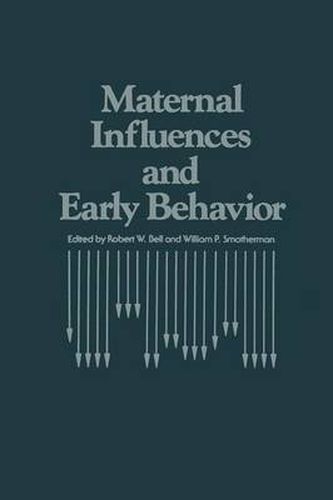Readings Newsletter
Become a Readings Member to make your shopping experience even easier.
Sign in or sign up for free!
You’re not far away from qualifying for FREE standard shipping within Australia
You’ve qualified for FREE standard shipping within Australia
The cart is loading…






This title is printed to order. This book may have been self-published. If so, we cannot guarantee the quality of the content. In the main most books will have gone through the editing process however some may not. We therefore suggest that you be aware of this before ordering this book. If in doubt check either the author or publisher’s details as we are unable to accept any returns unless they are faulty. Please contact us if you have any questions.
This book is intended to bring together the contributions of many years of investigations from a number of laboratories involved in the systematic investigation of mother-offspring interactions and the attendant conse quences for development. A similar book (Rheingold, 1963) is now more than a decade old. The value of such a book is attested to by the burgeoning interest in the subject matter since the publication of that earlier volume. The importance of the mother-infant dyad has been recognized by scientests and parents alike since time immemorial. Pioneering writers such as Sigmund Freud, with his emphasis upon the expression of biological needs by the developing infant, and John B. Watson, with his emphasis upon the mother’s role as a conditioner-trainer of her offspring, have been followed (in time, not emphases) by such investigators as Konrad Lorenz, with his now classic studies of imprinting, Jean Piaget’s sequential analyses of the development of intellect, and Harry Harlow’s ingenious studies of attach ment. The present volume reflects the influences of these earlier investigators. It is comparative, psychobiological, and represents a blend ofthe experimental approach characteristic of those trained in experimental psychology and the natural history approach more often represented in the work of ethologists. Sequential analyses of developmental changes in the mother-offspring relationship characterize virtually all of the work reported herein.
$9.00 standard shipping within Australia
FREE standard shipping within Australia for orders over $100.00
Express & International shipping calculated at checkout
This title is printed to order. This book may have been self-published. If so, we cannot guarantee the quality of the content. In the main most books will have gone through the editing process however some may not. We therefore suggest that you be aware of this before ordering this book. If in doubt check either the author or publisher’s details as we are unable to accept any returns unless they are faulty. Please contact us if you have any questions.
This book is intended to bring together the contributions of many years of investigations from a number of laboratories involved in the systematic investigation of mother-offspring interactions and the attendant conse quences for development. A similar book (Rheingold, 1963) is now more than a decade old. The value of such a book is attested to by the burgeoning interest in the subject matter since the publication of that earlier volume. The importance of the mother-infant dyad has been recognized by scientests and parents alike since time immemorial. Pioneering writers such as Sigmund Freud, with his emphasis upon the expression of biological needs by the developing infant, and John B. Watson, with his emphasis upon the mother’s role as a conditioner-trainer of her offspring, have been followed (in time, not emphases) by such investigators as Konrad Lorenz, with his now classic studies of imprinting, Jean Piaget’s sequential analyses of the development of intellect, and Harry Harlow’s ingenious studies of attach ment. The present volume reflects the influences of these earlier investigators. It is comparative, psychobiological, and represents a blend ofthe experimental approach characteristic of those trained in experimental psychology and the natural history approach more often represented in the work of ethologists. Sequential analyses of developmental changes in the mother-offspring relationship characterize virtually all of the work reported herein.